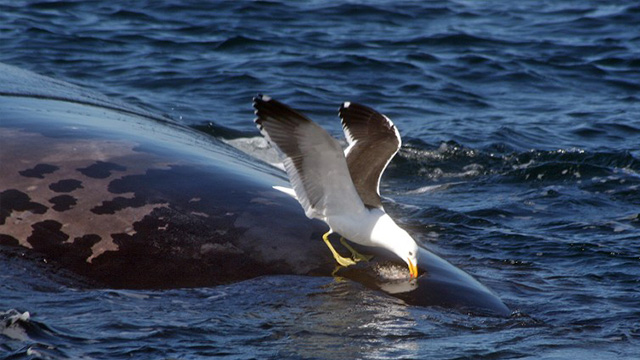SUMMARY
This is AI generated summarization, which may have errors. For context, always refer to the full article.

VALDES PENINSULA, Argentina – It’s a weird, lopsided fight if ever there was one: seagulls divebombing to attack and feed on the fat of 50-ton whales and their babies. And the birds are winning.
The battle, new in recent years, is playing out in the South Atlantic off the coast of Argentina’s Patagonia region, and is not known to be happening in waters elsewhere in the world that are home to the mighty mammals.
The effect of all the relentless nibbling is a pernicious disruption of an eco-system. One theory as to why it is happening is there is an overpopulation of seagulls — in this case, the kelp gull.
World heritage
Whales use these Argentine waters to mate, give birth and nurse their young, and what with all the airborne harassment, whales are taking new evasive measures as they swim, separating mothers from their calves and denying them nourishment.
Whales do not have lips for sucking, so mothers expel a thick milk in the water for their calves to ingest. The babies need more than 100 liters of it per day.
“With each attack this process is interrupted, and it is a crucial moment for the growth of the whales,” said Mariano Sironi, director of studies at Argentina’s Institute for Whale Conservation.
In 2012, Sironi tallied 116 whales found dead in these waters, and all but three of them were calves. That mortality rate was up 100 percent from the previous year.
Every year, for six months starting in June, hundreds of whales — their formal name is the southern right whale (Eubalaena australis) — come to waters off the Valdes Peninsula to reproduce. The area has been declared a UN World Heritage site, and every year more than 100,000 tourists come to watch the spectacle.
Dodging attacks
It is estimated that 1,500 to 2,000 whales, who like the cold waters of the South Atlantic, come for the annual mating fest. The species also live in the Antarctic, South Pacific and southern Indian Ocean.
Adults measure 13 to 16 meters (43 to 53 feet), while the calves are 3-5 meters at birth.
“The lack of nursing causes serious nutrition problems for the calves. Post-mortem studies have shown evidence of malnutrition, and this is a working hypothesis that needs to be confirmed with several studies,” Sironi said.
Indeed, in recent years the gulls have been wreaking havoc. They used to feed on refuse tossed overboard by fishing boats. Now, they have added whales to their menu in frenzied waves of pecking.
“The seagulls attack the skin first, and then the fat of the whales. They peck several times in each attack. Then the whale submerges, and when it comes back to the surface, the gull is there waiting,” said Jose Anibal Cepeda, a guide who takes tourists out on the ocean to see the whales.
The calves are a riper target because they have less lung capacity than adults and thus have to come up for air more often, he added.
Seagulls may be small but their beaks leave a grisly toll: gashes up to four inches (10 cm) deep and scabs up to five feet (1.5 meters) long.
Biologist Ana Fazio of the Patagonia National Center says whales have even changed the way they swim so as to dodge the birds.
“They arch as they swim to avoid exposing their backs. You can only see their head and their tail. They swim deeper. They are constantly fleeing. They spend an enormous amount of energy reacting to the seagull attacks,” Fazio said.
‘McDonald’s’ for seagulls
Last year the center’s director Marcelo Bertoletti hired professional hunters to cull gulls. They downed 140 of them.
About 10 kilometers (six miles) from the fishing port of Puerto Madryn, Bertoletti looks on as a monstrous flock of up to 8,000 gulls feed madly on rotting fish remains at a landfill. The stench is nauseating.
Those remains are supposed to be buried, but companies rarely do that, so the gulls gorge themselves on fish heads, tails and guts that helps their numbers multiply.
“This is like a McDonald’s for seagulls,” Bertoletti said.
He said there is also the fear that the gulls carry viruses or bacteria that can infect whales.
Whales of the same species in waters off South Africa or Australia have no seagull problem, so scientists reckon the Argentine phenomenon is caused by seagull overpopulation.
Experts discard whales beaching themselves or falling victim to solar radiation as an explanation for the increased mortality rate.
Authorities in southern Chubut province plan another seagull cull in July to try to keep the peace for the whales, which are the main tourist attraction in the Valdes Peninsula. – Rappler.com
Add a comment
How does this make you feel?
There are no comments yet. Add your comment to start the conversation.